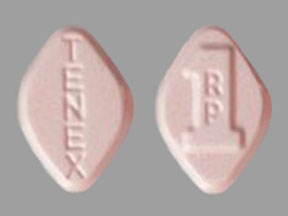Tenex Disease Interactions
There are 5 disease interactions with Tenex (guanfacine).
Alpha-2 agonists (central) (applies to Tenex) bradyarrhythmia
Moderate Potential Hazard, High plausibility. Applicable conditions: Heart Block, Sinus Node Dysfunction
Central alpha-2 adrenoreceptor agonists reduce sympathetic outflow from the central nervous system. Heart rate is decreased, which may lead to or exacerbate sinus bradycardia and atrioventricular block. Therapy with central alpha-2 adrenoreceptor agonists should be administered cautiously in patients with conduction disturbances such as sinus node dysfunction or AV nodal disease.
Alpha-2 agonists (central) (applies to Tenex) depression
Moderate Potential Hazard, Moderate plausibility.
Central alpha-2 adrenoreceptor agonists may occasionally cause mental depression and should be used cautiously in patients with a history of depression.
Alpha-2 agonists (central) (applies to Tenex) hypotension
Moderate Potential Hazard, High plausibility. Applicable conditions: Cerebrovascular Insufficiency, Ischemic Heart Disease, Peripheral Arterial Disease
Central alpha-2 adrenoreceptor agonists reduce sympathetic outflow from the central nervous system, resulting in decreases in heart rate, peripheral and renovascular resistance, and blood pressure. Therapy with these agents should be administered cautiously in patients with hypotension or conditions that may be exacerbated by decreased blood pressure and perfusion, such as coronary insufficiency, peripheral vascular disease (e.g., Raynaud's syndrome), cerebrovascular disease, or recent myocardial infarction.
Guanfacine (applies to Tenex) ADHD
Moderate Potential Hazard, Moderate plausibility. Applicable conditions: Hyperkinetic Syndrome of Childhood
The safety and effectiveness of guanfacine in children under 12 years of age has not been demonstrated and its use in this age group is not recommended. However, there have been some spontaneous postmarketing reports of mania and aggressive behavioral changes in pediatric patients with attention- deficit hyperactivity disorder (ADHD) that received this drug. All patients had medical or family risks of bipolar disorder, and all of them recovered after treatment discontinuation. Hallucinations have also been reported in pediatric patients receiving guanfacine for the treatment of ADHD.
Guanfacine (applies to Tenex) renal/liver disease
Moderate Potential Hazard, Low plausibility. Applicable conditions: Renal Dysfunction
Normally, approximately 50% of a guanfacine dose is eliminated unchanged by the kidney and the rest metabolized by the liver. However, neither the parent drug nor its metabolites accumulate significantly during chronic dosing in patients with severe renal impairment due to increased hepatic metabolism of the drug in these patients. Thus, initial dosage adjustments are generally not necessary in renal impairment. Dosage titration, however, should be made cautiously if hepatic function is also compromised. The pharmacokinetics of guanfacine has not been studied in patients with liver disease. The manufacturer recommends caution when the drug is used in such patients.
Switch to professional interaction data
Tenex drug interactions
There are 494 drug interactions with Tenex (guanfacine).
Tenex alcohol/food interactions
There is 1 alcohol/food interaction with Tenex (guanfacine).
More about Tenex (guanfacine)
- Tenex consumer information
- Check interactions
- Compare alternatives
- Reviews (9)
- Drug images
- Latest FDA alerts (1)
- Side effects
- Dosage information
- During pregnancy
- Drug class: antiadrenergic agents, centrally acting
- Breastfeeding
Related treatment guides
Drug Interaction Classification
| Highly clinically significant. Avoid combinations; the risk of the interaction outweighs the benefit. | |
| Moderately clinically significant. Usually avoid combinations; use it only under special circumstances. | |
| Minimally clinically significant. Minimize risk; assess risk and consider an alternative drug, take steps to circumvent the interaction risk and/or institute a monitoring plan. | |
| No interaction information available. |
See also:
Further information
Always consult your healthcare provider to ensure the information displayed on this page applies to your personal circumstances.


